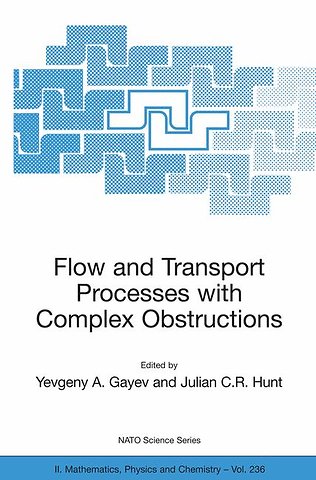Flow and Transport Processes with Complex Obstructions
Applications to Cities, Vegetative Canopies and Industry
Samenvatting
This is the first book that reviews problems in different fluid mechanics disciplines that led to the concept of canopy, or penetrable roughness. Despite their diversity, many flows may be theoretically united by means of introducing distributed sinks and/or sources of momentum and heat and mass. These and other flows in engineering and environmental situations over surfaces with many obstacles are reviewed in terms of general concepts of fluid mechanics.
Specificaties
Inhoudsopgave
1. Canopies, or EPRs; Ye. Gayev.- 1.1. Vegetative canopies in meteorology.- 1.2. Vegetated river beds.- 1.3. Urban canopies.- 1.4. Spraying coolers.- 1.5. Other examples of EPR.- 1.6. Laboratory modelling of the canopy flows.- 1.7. Preliminary conclusion. Turbulence.-
2. Discrete and continuum models; J.C.R. Hunt et al..- 2.1. Introduction.- 2.2. Over/through canopies.- 2.3. Computational models.- 2.4. Dispersion in canopies.- 2.5. Conclusion.- 2.6. Appendix A: Dispersion in street canyon.- 2.7. Appendix B: Notation and abbreviations.-
3. EPR of different structure; Ye. Gayev.- 3.1. EPR of immobile elements.- 3.2. EPRs made up of mobile elements.- 3.3. Turbulence in EPRs.-
4. Flow in vegetation canopies; R.H. Shaw.- 4.1. Introduction.- 4.2. Flow Above The Canopy.- 4.3. Flow Within The Canopy.- 4.4. Computational Representations of Canopy Flow.- 4.5. Higher-Order Closure Schemes.- 4.6. Large-Eddy Simulation.- 4.7. Contribution of Canopy Elements.- 4.8. Conditional Sampling and Composite Averaging.- 4.9. Empirical Orthogonal Function (EOF) Analysis.- 4.10. Summary.-
5. Topography and stable stratification; J. Finnigan.- 5.1. Introduction.- 5.2. The windfield over a canopy covered hill.- 5.3. The scalar field over a canopy covered hill.- 5.4. Stable Stratification.- 5.5. Summary and conclusions.-
6. Aquatic Canopies; H. Nepf et al.- 6.1. Introduction: Comparison of Aquatic and Terrestrial Canopies.- 6.2. Emergent Canopies.- 6.3. Diffusion within Emergent Vegetation.- 6.4. Submerged Canopies.- 6.5. Summary.-
7. Vorticity annihilation, inviscid blocking; I. Eames et al.- 7.1. Introduction.- 7.2. Vorticity annihilation.- 7.3. Inviscid blocking.- 7.4. Modelling drag forces.- 7.5. Bubbly flows: high void fraction, high Re.- 7.6. Concluding remarks.-
8. Fires in Porous Media; R.N. Meroney.- 8.1. Introduction.- 8.2. Forest and wildland fire statistics.- 8.3. Historic large urban fires.- 8.4. Fire classification.- 8.5. Modeling methodologies.- 8.6. Forest and urban climate meteorology.- 8.7. Fluid mechanics of fires and porous canopies.- 8.8. Fire whirls and fire tornadoes.- 8.9. Numerical Modeling Fire Whirls.- 8.10. Conclusions and recommendations.-
9. Air emergencies and urban weather; A. Baklanov.- 9.1. Introduction.- 9.2. Applications to Urban Meteorology and Air Quality.- 9.3. Applications to Emergency Preparedness.- Conclusion.-
Bibliography.- Index.

